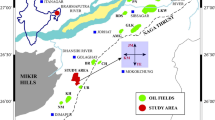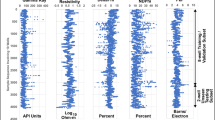Abstract
The “facies” is a frequently used term for describing sedimentary units. In the literature, this term has been used for different purposes, as depositional environment, rock type, lithofacies, etc. In subsurface geology, the core samples are essential for facies studies. While lacking cored intervals, the well logs provide precious subsurface information, but the complexity of well log responses leads most of the time to the complexity of interpretations. In this paper, a method is proposed to study the facies types through well logs. The case study is a carbonate platform system, deposited in the upper Cretaceous, named Sarvak Formation, in one of Iranian onshore oilfields, located in the Abadan Plain. For this purpose, parametric and non-parametric (k-nearest neighbor) classifiers were applied to the dataset. Detailed petrography, assisted by core descriptions, led to 37 microfacies, grouped into three main lithofacies, four carbonate rock types and six environmental facies. Classifiers could not identify the microfacies due to a limited number of observations and high variations. However, the environmental facies were truly classified. In addition, lithofacies classification and Dunham carbonate rock typing were carried out correctly. It is discussed that k-nearest neighbor is clearly the outperformed classifier, and the classical parametric models were inadequate due to the nature of the input well logs (dependency of well logs and may be their distribution), and the overlapping of the input feature space.
Graphical abstract









Similar content being viewed by others
References
Aqrawi AAM, Thehni GA, Sherwani GH, Kareem BMA (1998) Mid-Cretaceous rudist bearing carbonates of the Mishrif Formation: An important reservoir sequence in the Mesopotamian Basin, Iraq. J Pet Geol 21(1):57–82
Assadi A, Honarmand J, Moallemi SA, Abdollahie-Fard I (2016) Depositional environments and sequence stratigraphy of the Sarvak Formation in an oil field in the Abadan Plain, SW Iran. Facies 62(4):26
Avseth P, Mukerji T, Jorstad A, Mavko G, Veggeland T (2001) Seismic reservoir mapping from 3-D AVO in a North Sea turbidite system. Geophysics 66(4):1157–1176
Bashari A (2007) Integrated 3D seismic and petrophysical data of the Sarvak formation, Sirri district in the Persian Gulf. 14th European Symposium on Improved Oil Recovery, Cairo, Egypt, 22–24 April Extended Abstract
Bates RL, Jackson JA (1987) Glossary of geology. American Geological Institute, Alexandria, p 788
Bhatt A, Helle H (2002) Determination of facies from well logs using modular neural networks. Pet Geosci 8(3):217–228
Busch JM, Fortney WG, Berry LN (1987) Determination of lithology from well logs by statistical analysis. SPE Form Eval 2:412–418
Clark P, Niblett T (1989) The CN2 induction algorithm. Mach Learn 3(4):261–283
Cuddy S (2000) Litho-facies and permeability prediction from electrical logs using fuzzy logic. SPE Reserv Eval Eng 3(4):319–324
Delfiner P, Peyret O, Serra O (1987) Automatic determination of lithology from well logs. SPE Form Eval 2:303–310
Derek H, Johns R, Pasternack E (1990) Comparative study of a backpropagation neural network and statistical pattern recognition techniques in identifying sandstone lithofacies. Proceedings 1990 Conference on Artificial Intelligence in Petroleum Exploration and Production. Texas A and M University, College Station, TX, p 41–49
Dubois MK, Bohling GC, Chakrabarti S (2007) Comparison of four approaches to a rock facies classification problem. Comput Geosci 33:599–617
Duda RO, Hart PE, Stork DG (2001) Pattern Classification. Wiley Inc, New York, p 654
Dunham RJ (1962) Classification of carbonate rocks according to depositional texture. In: Ham WE (ed) Classification of carbonate rocks: a symposium. Am. Assoc. Pet. Geol., Tulsa, pp 108–121
Embry AF, Klovan JE (1971) A late Devonian reef tract on northeastern Banks Island. N.W.T. Bull Can Petrol Geol 19:730–781
Ghabeishavi A, Vaziri-Moghaddam H, Taheri A, Taati F (2010) Microfacies and depositional environment of the Cenomanian of the Bangestan anticline, SW Iran. J Asian Earth Sci 37:275–285
Grötsch J, Mercadier C (1999) Integrated 3-D reservoir modeling based on 3-D seismic: the Tertiary Malampaya and Camago buildups, offshore Palawan, Philippines. AAPG Bulletin 83(11):1703–1728
Gressly A (1838) Observations geologiques sur le Jura Soleurois. Neue Denkschr Allg Schweiz Ges Gesamten Naturwiss 2:1–112
International Stratigraphic Guide. (1976) A Guide to Stratigraphic Classification, Terminology and Procedure, by the International Subcommission on Stratigraphic Classification of IUGS Commission of Stratigraphy. In: Hedberg HD. Editorial Committee: Nevile George, Hollis Hedberg, Charles Pomerol, Amos Salvador, and Jovan Stöklin. Wiley Interscience Publication, New York, p 200
James GA, Wynd JG (1965) Stratigraphic nomenclature of Iranian oil consortium agreement area. AAPG Bull. 49(12):2182–2245
Jooybari A, Rezaie P (2017) Petrophysical evaluation of the Sarvak Formation based on well logs in Dezful Embayment, Zagros fold zone, South West of Iran. Eng. Tech Appl Sci Res 7(1):1358–1362
Kapur L, Lake L, Sepehrnoori K (2000) Probability logs for facies classification. Situ 24(1):57–58
Krumbein WC, Sloss LL (1963) Properties of sedimentary rocks. Stratigraphy and sedimentation. W. H. Freeman, San Francisco, pp 106–113
Langley P, Iba W, Thompson K (1992) An analysis of Bayesian classifiers. Proceedings of the Tenth National Conference on Artificial Intelligence. AAAI Press, San Jose
Li Y, Anderson-Sprecher R (2006) Facies identification from well logs: a comparison of discriminant analysis and naïve Bayes classifier. J Petrol Sci Eng 53:149–157
Masoudi P, Tokhmechi B, Bashari A, Ansari Jafari M (2012) Identifying productive zones of the Sarvak formation by integrating outputs of different classification methods. J Geophys Eng 9:282–290
Masoudi P, Arbab B, Mohammadrezaei H (2014) Net pay determination by artificial neural network, Case Study on Iranian Offshore Oil Fields. J Petrol Sci Eng 123(1):72–77
Mehrabi H, Rahimpour-Bonab H (2014) Paleoclimate and tectonic controls on the depositional and diagenetic history of the Cenomanian–early Turonian carbonate reservoirs, Dezful Embayment, SW Iran. Facies 60(1):147–167
Mehrabi H, Rahimpour-Bonab H, Hajikazemi E, Jamalian A (2015) Controls on depositional facies in Upper Cretaceous carbonate reservoirs in the Zagros area and the Persian Gulf, Iran. Facies 61(4):1–24
Mollajan A, Memarian H, Nabi-Bidhendi M (2016) Fuzzy classifier fusion: an application to reservoir facies identification. Neural Comput Appl. doi:10.1007/s00521-016-2690-0
Moore RC (1949) Meaning of facies. Mem-Geol Soc Am 39:1–34
Rajabi M, Sherkati S, Bohloli B, Tingay M (2010) Subsurface fracture analysis and determination of in situ stress direction using FMI logs: an example from the Santonian carbonates (Ilam Formation) in the Abadan Plain, Iran. Tectonophysics 492:192–200
Reading HG (1978) Sedimentary environments and facies. Blackwell Scientific, Oxford, p 557
Russell SD, Abkar M, Vissapragada B, Walkden GM (2002) Rock types and permeability prediction from dipmeter and image logs: Shuaiba reservoir (Aptian), Abu Dhabi. AAPG Bull 86(10):1709–1732
Saggaf MM, Nebrija EL (2000) Estimation of lithologies and depositional facies from wire-line logs. AAPG Bull 84:1633–1646
Saggaf MM, Nebrija EL (2003) A fuzzy logic approach for the estimation of facies from wire-line logs. AAPG Bull 87(7):1223–1240
Sakurai S Melvin J (1988) Facies discrimination and permeability estimation from well logs for the Endicott field. 29th Annual APWLA Symposium. San Antonio, Texas
Selley RC (1970) Ancient sedimentary environments. Chapman & Hall, London, p 237
Sherkati S, Letouzey J (2004) Variation of structural style and basin evolution in the central Zagros (Izeh zone and Dezful Embayment), Iran. Mar Pet Geol 21:535–554
Siripitayananon P, Chen H, Hart B (2001) A new technique for lithofacies prediction: back-propagation neural network. Proceedings of the 39th Annual ACM-SE Conference
Soleimani Asl S, Aleali M (2016) Microfacies patterns and depositional environments of the Sarvak Formation in the Abadan Plain, Southwest of Zagros, Iran. Open J Geol 6(3):201–209
Taghavi AA, Mørk A, Emadi MA (2006) Sequence stratigraphically controlled diagenesis governs reservoir quality in the carbonate Dehluran Field, southwest Iran. Pet Geosci 12:115–126
Tang H, White C, Zeng X, Gani M, Bhattacharya J (2004) Comparison of multivariate statistical algorithms for wireline log facies classification. AAPG Annual Meeting Abstract, vol 88, p 13
Theodoridis S, Koutroumbas K (2008) Pattern recognition, 4th edn. Academic Press, New York, p 984. https://www.elsevier.com/books/pattern-recognition/theodoridis/978-1-59749-272-0
Wolf M, Pelissier-Combesecure J, (1982) FACIOLOG: automated electrofacies determination. In: Transactions of the 23rd Society of Professional Well Log Analysts Annual Logging Symposium, Corpus Christi, TX, paper FF, p 22
Wong P, Jian F, Taggart I (1995) A critical comparison of neural networks and discriminant analysis in lithofacies, porosity and permeability predictions. J Pet Geol 18(2):191–206
Acknowledgements
The authors would like to thank the Exploration Directorate of the National Iranian Oil Co. (NIOC), for providing the data, and permitting the publication of the scientific achievements.
Author information
Authors and Affiliations
Corresponding author
Additional information
Majid Moradi: Deceased.
Rights and permissions
About this article
Cite this article
Moradi, M., Tokhmechi, B. & Masoudi, P. Inversion of well logs into rock types, lithofacies and environmental facies, using pattern recognition, a case study of carbonate Sarvak Formation. Carbonates Evaporites 34, 335–347 (2019). https://doi.org/10.1007/s13146-017-0388-8
Accepted:
Published:
Issue Date:
DOI: https://doi.org/10.1007/s13146-017-0388-8




